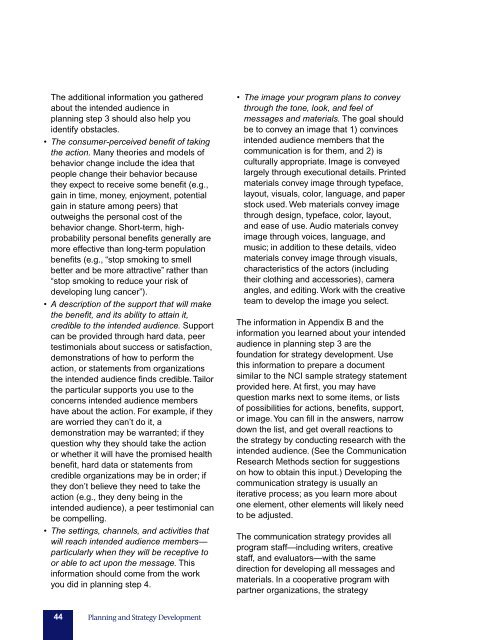pink-book
pink-book
pink-book
Create successful ePaper yourself
Turn your PDF publications into a flip-book with our unique Google optimized e-Paper software.
The additional information you gathered<br />
about the intended audience in<br />
planning step 3 should also help you<br />
identify obstacles.<br />
• The consumer-perceived benefit of taking<br />
the action. Many theories and models of<br />
behavior change include the idea that<br />
people change their behavior because<br />
they expect to receive some benefit (e.g.,<br />
gain in time, money, enjoyment, potential<br />
gain in stature among peers) that<br />
outweighs the personal cost of the<br />
behavior change. Short-term, highprobability<br />
personal benefits generally are<br />
more effective than long-term population<br />
benefits (e.g., “stop smoking to smell<br />
better and be more attractive” rather than<br />
“stop smoking to reduce your risk of<br />
developing lung cancer”).<br />
• A description of the support that will make<br />
the benefit, and its ability to attain it,<br />
credible to the intended audience. Support<br />
can be provided through hard data, peer<br />
testimonials about success or satisfaction,<br />
demonstrations of how to perform the<br />
action, or statements from organizations<br />
the intended audience finds credible. Tailor<br />
the particular supports you use to the<br />
concerns intended audience members<br />
have about the action. For example, if they<br />
are worried they can’t do it, a<br />
demonstration may be warranted; if they<br />
question why they should take the action<br />
or whether it will have the promised health<br />
benefit, hard data or statements from<br />
credible organizations may be in order; if<br />
they don’t believe they need to take the<br />
action (e.g., they deny being in the<br />
intended audience), a peer testimonial can<br />
be compelling.<br />
• The settings, channels, and activities that<br />
will reach intended audience members—<br />
particularly when they will be receptive to<br />
or able to act upon the message. This<br />
information should come from the work<br />
you did in planning step 4.<br />
• The image your program plans to convey<br />
through the tone, look, and feel of<br />
messages and materials. The goal should<br />
be to convey an image that 1) convinces<br />
intended audience members that the<br />
communication is for them, and 2) is<br />
culturally appropriate. Image is conveyed<br />
largely through executional details. Printed<br />
materials convey image through typeface,<br />
layout, visuals, color, language, and paper<br />
stock used. Web materials convey image<br />
through design, typeface, color, layout,<br />
and ease of use. Audio materials convey<br />
image through voices, language, and<br />
music; in addition to these details, video<br />
materials convey image through visuals,<br />
characteristics of the actors (including<br />
their clothing and accessories), camera<br />
angles, and editing. Work with the creative<br />
team to develop the image you select.<br />
The information in Appendix B and the<br />
information you learned about your intended<br />
audience in planning step 3 are the<br />
foundation for strategy development. Use<br />
this information to prepare a document<br />
similar to the NCI sample strategy statement<br />
provided here. At first, you may have<br />
question marks next to some items, or lists<br />
of possibilities for actions, benefits, support,<br />
or image. You can fill in the answers, narrow<br />
down the list, and get overall reactions to<br />
the strategy by conducting research with the<br />
intended audience. (See the Communication<br />
Research Methods section for suggestions<br />
on how to obtain this input.) Developing the<br />
communication strategy is usually an<br />
iterative process; as you learn more about<br />
one element, other elements will likely need<br />
to be adjusted.<br />
The communication strategy provides all<br />
program staff—including writers, creative<br />
staff, and evaluators—with the same<br />
direction for developing all messages and<br />
materials. In a cooperative program with<br />
partner organizations, the strategy<br />
44 Planning and Strategy Development


